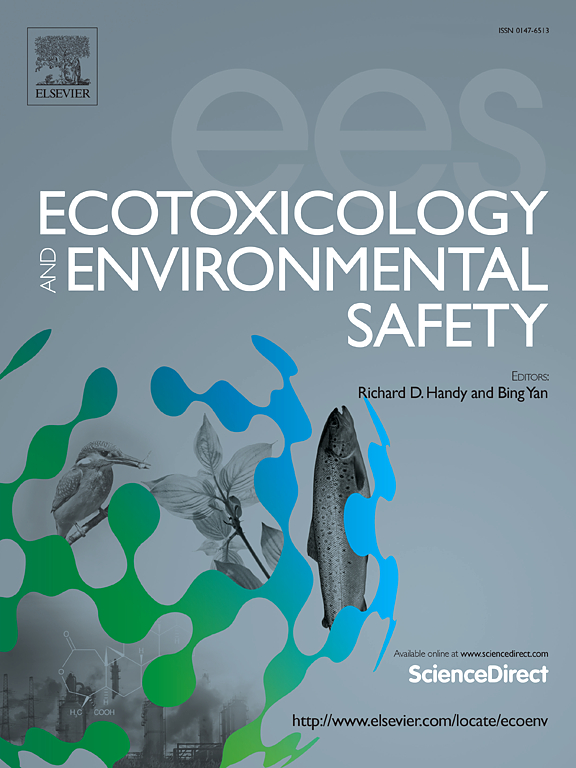黄芪甲苷II预处理通过MAPK/Nrf2/GPX4轴介导的铁上吊抑制减轻pm2.5诱导的小鼠肺损伤
IF 6.1
2区 环境科学与生态学
Q1 ENVIRONMENTAL SCIENCES
引用次数: 0
摘要
暴露于细颗粒物(PM2.5)会诱发炎症和氧化应激,导致呼吸系统疾病,包括肺损伤。黄芪甲苷(Astragaloside II, AS II)是从黄芪(Astragali Radix, AR)中提取的天然产物,具有抗炎和抗氧化双重活性。本研究使用小鼠模型系统地评估了AS II的预防功效和减轻pm2.5引发的肺损伤的分子途径。气管内应用PM2.5悬浮液(7.5 mg/kg),在污染物挑战之前通过腹腔注射预处理AS II(25和50 mg/kg)。结果表明,AS II可减轻pm2.5引起的肺损伤,减轻肺水肿和炎症,降低肿瘤坏死因子-α (TNF-α)和白细胞介素-1β (IL-1β)水平。AS II上调谷胱甘肽(GSH)和过氧化氢酶(CAT)水平,下调活性氧(ROS)和丙二醛(MDA)水平。在机制上,AS II抑制丝裂原活化蛋白激酶(MAPK)信号通路,激活核因子红细胞2相关因子2 (Nrf2),增强谷胱甘肽过氧化物酶4 (GPX4)的表达,升高其他抗氧化蛋白,同时抑制铁凋亡和氧化应激标志物。为了进一步验证铁下垂的作用,使用rsl3 -一种结合并灭活gpx4的小分子铁下垂激动剂。asii对肺损伤的保护作用被rsl3诱导的GPX4失活有效抵消。总的来说,AS II通过调节MAPK/NRF2/GPX4信号轴抑制铁下沉来保护pm2.5诱导的肺损伤,从而为治疗pm2.5相关肺部疾病提供了一种新的治疗策略。本文章由计算机程序翻译,如有差异,请以英文原文为准。
Astragaloside II pretreatment alleviates PM2.5-induced lung injury in mice via MAPK/Nrf2/GPX4 axis-mediated suppression of ferroptosis
Exposure to fine particulate matter (PM2.5) induces inflammation and oxidative stress, contributing to respiratory diseases, including lung injury. Astragaloside II (AS II), a natural product derived from Astragali Radix (AR), demonstrates dual anti-inflammatory and antioxidant activities. This work systematically evaluates AS II's prophylactic efficacy and molecular pathways in mitigating PM2.5-triggered pulmonary damage using a murine model. Intratracheal PM2.5 suspension (7.5 mg/kg) was applied, with AS II (25 and 50 mg/kg) pretreated via intraperitoneal (i.p.) injection before the pollutant challenge. Results demonstrated that AS II alleviated PM2.5-induced lung injury, mitigated pulmonary edema and inflammation, and reduced levels of tumor necrosis factor-α (TNF-α) and interleukin-1β (IL-1β). AS II upregulated glutathione (GSH) and catalase (CAT) levels while downregulating reactive oxygen species (ROS) and malondialdehyde (MDA). Mechanistically, AS II inhibited the mitogen-activated protein kinase (MAPK) signalling pathway, activated nuclear factor erythroid 2-related factor 2 (Nrf2), enhanced expression of glutathione peroxidase 4 (GPX4), and elevated other antioxidant proteins while suppressing ferroptosis and oxidative stress markers. To further validate the role of ferroptosis, RSL3—a small-molecule ferroptosis agonist that binds and inactivates GPX4—was employed. The protective efficacy of AS II against lung injury was effectively counteracted by RSL3-induced GPX4 inactivation. Collectively, AS II protects against PM2.5-induced pulmonary injury by modulating the MAPK/NRF2/GPX4 signaling axis to inhibit ferroptosis, thereby providing a novel therapeutic strategy for the treatment of PM2.5-associated pulmonary diseases.
求助全文
通过发布文献求助,成功后即可免费获取论文全文。
去求助
来源期刊
CiteScore
12.10
自引率
5.90%
发文量
1234
审稿时长
88 days
期刊介绍:
Ecotoxicology and Environmental Safety is a multi-disciplinary journal that focuses on understanding the exposure and effects of environmental contamination on organisms including human health. The scope of the journal covers three main themes. The topics within these themes, indicated below, include (but are not limited to) the following: Ecotoxicology、Environmental Chemistry、Environmental Safety etc.

 求助内容:
求助内容: 应助结果提醒方式:
应助结果提醒方式:


